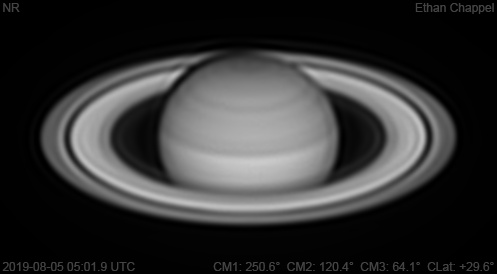
Saturn UTC
CM1: 250.60°
CM2: 120.40°
CM3: 64.10°
CLat: +29.60°
Description
After imaging Jupiter with marginally good conditions, I encountered slightly better seeing while imaging Saturn.
Notes:
- The hexagon has a bright ring around the north pole.
- The North Equatorial Belt is split by a band.
Equipment
ZWO ASI290MM
Astro-Physics Advanced Convertible Barlow
Celestron EdgeHD 8
Logs
FireCapture v2.6 Settings ------------------------------------ Observer=Ethan Chappel Camera=ZWO ASI290MM Filter=IR Profile=Saturn Diameter=18.11" Magnitude=0.20 CMI=251.3° CMIII=64.8° (during mid of capture) FocalLength=4000mm (F/14) Resolution=0.15" Filename=2019-08-05-0503_2-EC-IR-Sat.ser Date=2019_08_05 Start=05_02_02.795 Mid=05_03_17.799 End=05_04_32.804 Start(UT)=05_02_02.795 Mid(UT)=05_03_17.799 End(UT)=05_04_32.804 Duration=150.009s Date_format=yyyy_MM_dd Time_format=HH_mm_ss LT=UT -6h Frames captured=7500 File type=SER Binning=no Bit depth=8bit Debayer=no ROI=568x306 ROI(Offset)=0x0 FPS (avg.)=49 Shutter=20.00ms Gain=370 (61%) AutoExposure=off SoftwareGain=10 (off) Brightness=1 (off) FPS=100 (off) AutoGain=off AutoHisto=75 (off) Gamma=50 HighSpeed=off USBTraffic=40 (off) Histogramm(min)=0 Histogramm(max)=118 Histogramm=46% Noise(avg.deviation)=0.65 AutoAlign=false PreFilter=none Limit=150 Seconds Sensor temperature=34.8°C FireCapture v2.6 Settings ------------------------------------ Observer=Ethan Chappel Camera=ZWO ASI290MM Filter=IR Profile=Saturn Diameter=18.11" Magnitude=0.20 CMI=249.8° CMIII=63.3° (during mid of capture) FocalLength=4000mm (F/14) Resolution=0.15" Filename=2019-08-05-0500_5-EC-IR-Sat.ser Date=2019_08_05 Start=04_59_19.573 Mid=05_00_34.579 End=05_01_49.586 Start(UT)=04_59_19.573 Mid(UT)=05_00_34.579 End(UT)=05_01_49.586 Duration=150.013s Date_format=yyyy_MM_dd Time_format=HH_mm_ss LT=UT -6h Frames captured=7500 File type=SER Binning=no Bit depth=8bit Debayer=no ROI=568x306 ROI(Offset)=0x0 FPS (avg.)=49 Shutter=20.00ms Gain=370 (61%) AutoExposure=off SoftwareGain=10 (off) Brightness=1 (off) FPS=100 (off) AutoGain=off AutoHisto=75 (off) Gamma=50 HighSpeed=off USBTraffic=40 (off) Histogramm(min)=0 Histogramm(max)=126 Histogramm=49% Noise(avg.deviation)=0.65 AutoAlign=false PreFilter=none Limit=150 Seconds Sensor temperature=34.8°C